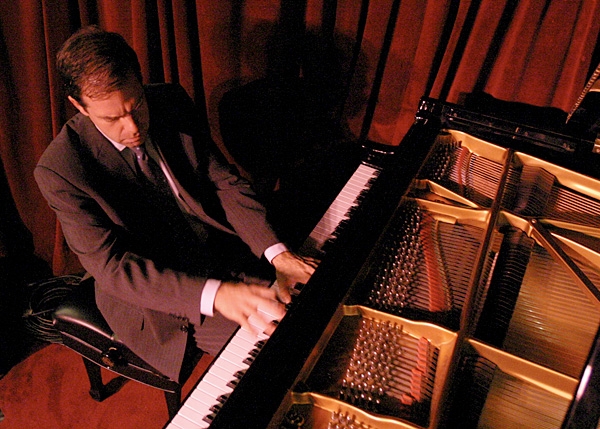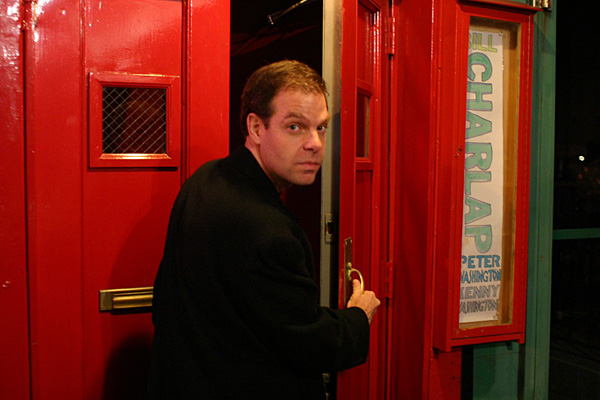| Columns Retired Columns & Blogs |
Thank You! SM
for such an excellent piece on BC. Been a big fan of his trio as well as his lovely wife RR, for a long time. Happy Holidays!

Born in 1966, Charlap grew up immersed in the New York music world. His father, Mark "Moose" Charlap (1928–1974), was a composer with significant Broadway credits (in the 1950s–70s Moose composed most of Peter Pan, including "I've Gotta Crow" and "I Won't Grow Up," Whoop-Up, The Conquering Hero, Kelly, and Clown Around), and his mother, Sandy Stewart, is a professional singer and recording artist. Bill Charlap's discography currently lists 29 albums as a leader, and dozens more as a coleader or sideman. Love Is Here to Stay, released last September, features Tony Bennett and Diana Krall backed by the Bill Charlap Trio (Verve/Columbia B0028705-01). A 2005 release with the same title is a duo session with Sandy Stewart (Blue Note 560430 2). In 2007, Charlap married fellow jazz pianist Renee Rosnes; their wedding took place at Jazz at Lincoln Center's Dizzy's Club Coca-Cola, and the couple perform and record together as a piano duo. Talk about a life in jazz. Charlap also puts his encyclopedic, boots-on-the-ground musical knowledge to work as artistic director of the annual Jazz in July series at New York's 92nd Street Y, and as director of jazz studies at William Paterson University, in Wayne, New Jersey.

Sitting right next to the small stage at the Village Vanguard, I could feel the physical strength in Charlap's playing. In up-tempo numbers he reached down to slap low notes almost like a kick-drum effect. At the upper end of the keyboard he took blazingly fast runs at what drummer Kenny Washington described, after one set, as nose-bleed tempos. Charlap doesn't ever just fill time, and always communicates the melodic line to support the lyric. In "Only a Paper Moon," played as a very slow ballad, he floated notes up into the air, where they lingered like gliders hanging in space.
I caught up with Charlap for a conversation on Manhattan's Upper West Side, as the autumn leaves were beginning to turn.
Sasha Matson: How was it working again with Tony Bennett, and adding Diana Krall to the mix?
Bill Charlap: It was a natural. I've known Tony for years and years, and Diana is a great musician and pianist and knows what it is to be in the rhythm section—she knows how to listen and react in that kind of way. Kenny and Peter are my musical brothers and family for 20 years.
Matson: A lot of jazz players cover Gershwin.
Charlap: In a sense, Gershwin was a jazz musician. He said that jazz is the sound of the American soul. And in the 1920s, it wasn't entirely clear what we were talking about when we said "jazz." Tony says, "I'm singing jazz." And what he means by that is, he's phrasing in a way that is related to the rhythm section. Also, a piece of it was arrangement and attitude. The way Gershwin played his own songs has been very influential to me.
Matson: It's good that a few Gershwin piano rolls have survived.
Charlap: Those are very important. Very important to understanding his harmonic imagination. Gershwin is central to the music, and a perfect canvas, pregnant with ideas for an improviser and an interpreter of the songs.
Matson: Diana Krall handed off the piano baton to you.
Charlap: It's the whole group—it is the trio. This allowed the communication between the two of them to be on a one-to-one basis—communicating and reacting just to that.
Matson: Did that go down live—the two of them and your trio?
Charlap: Sure. No headphones! [laughs]
Matson: When did you first focus on jazz performance and think you might like to do that? How did that come about in your life?
Charlap: Very naturally. I grew up in New York City. My parents were both great musicians. My dad was a composer. I remember the energy of a composer playing his own music—he had a beautiful sense of time and a rhythmic sense. And there's my mother, who is a great singer—a singer who swings, who sang with Benny Goodman. In my home, there were many composers and lyricists—all this music was around. And going to the High School for the Performing Arts—and at that time thinking about being a rock'n'roller, particularly the progressive keyboard bands at that time. I got to jazz because of my parents' record collection—it was hearing Oscar Peterson and Bill Evans, Cedar Walton. Gerry Mulligan's music, and Charlie Parker—all of that at once.
Matson: Do you remember when you first got into any of the real jazz clubs?
Charlap: I remember sitting at Bradley's, listening to people like Tommy Flanagan and Kenny Barron. I was just a kid sitting at the bar with my sarsaparilla. This was pre-Marsalis—jazz was kind of swimming a bit. But Bradley's was about bebop, and the song. If you played Bradley's, you had to know tunes.

Thank You! SM
for such an excellent piece on BC. Been a big fan of his trio as well as his lovely wife RR, for a long time. Happy Holidays!

I especially liked Bill Charlap's thoughtful comments on improvisation. My favorite contemporary jazz pianist.
Also, if you're reading this, Mr. Charlap, a big thank you to you and your label for somehow resisting the loudness wars that have infiltrated the jazz genre, a gift to both current and future generations for the opportunity to hear you and your trio with the subtlety, shadow, depth and emotion that the wide dynamic range on your recordings reveals.